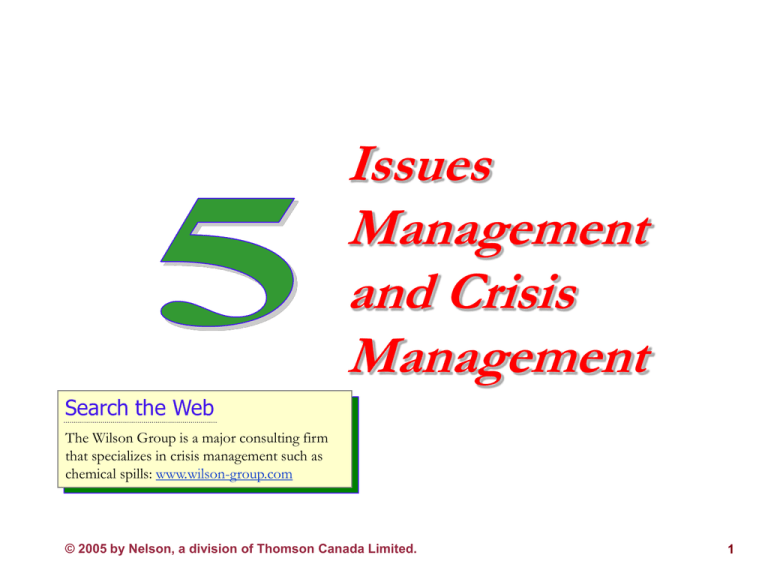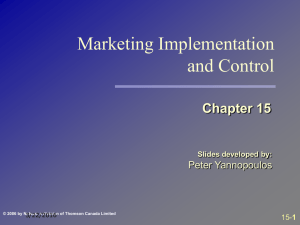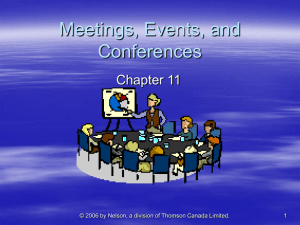Issues Management and Crisis Search the Web
advertisement

Issues Management and Crisis Management Search the Web The Wilson Group is a major consulting firm that specializes in crisis management such as chemical spills: www.wilson-group.com © 2005 by Nelson, a division of Thomson Canada Limited. 1 Chapter Five Objectives • How are Issues and Crises different? • Distinguish between the conventional and strategic management approaches to issues management • Identify the stages in the issues management process • Describe the components in the issues development process and factors in actual practice • Define and identify the four crisis stages • Outline the stages in managing business crises © 2005 by Nelson, a division of Thomson Canada Limited. 2 Issues Management Basic assumptions – Issues can be identified earlier, completely, and reliably – Early anticipation widens the range of options – Early anticipation permits an understanding – Early anticipation permits a positive orientation – Early identification identifies the stakeholders – Early identification provides the opportunity for the organization to supply information about the issue earlier © 2005 by Nelson, a division of Thomson Canada Limited. 3 Crisis Management Crisis Definitions • A major, unpredictable event that has negative results that damage an organization • A low-probability event that threatens the viability of the organization and has an ambiguous cause, effect, and resolution © 2005 by Nelson, a division of Thomson Canada Limited. 4 Issues and Crises • Examples of Issues: • Examples of Crises: 1) 2) 3) 4) 5) 6) 1) World Trade Center 2) Tylenol poisonings 3) Union Carbide Bhopal 4) Exxon Valdez spill 5) Ford / Firestone tire failures Product safety Employee rights Deceptive advertising Sexual harassment Bribery Workplace safety © 2005 by Nelson, a division of Thomson Canada Limited. 5 Issues Management Conventional Approach •Issues fall within the domain of public policy or public affairs management. •Issues have a public policy/public affairs orientation. •An issue is any trend, event, Strategic Management Approach controversy, or public develop• Issues management is the ment that might affect the responsibility of senior line or strategic corporation. management staff. •Issues originate in social/ • Issues identification is more political/ regulatory/ important than it is in the conventional judicial environments. approach. • Issues management is seen as management of external/internal • challenges to company strategies, • plans, and assumptions. © 2005 by Nelson, a division of Thomson Canada Limited. 6 Model of Issues Management Process Identification of Issues Analysis of Issues Prioritization of Issues Formulation of Issue Responses Implementation of Issue Responses Evaluation, Monitoring, and Control of Results © 2005 by Nelson, a division of Thomson Canada Limited. 7 Issues Management Process Identification of Issues • Scan the environment • Identify emerging issues • An issue is a matter that is in dispute between two parties • Issues are often stated in value laden terms © 2005 by Nelson, a division of Thomson Canada Limited. 8 Issues Management Process Analysis of Issues • • • • • • • Which stakeholders are affected? Who has a vested interest? Who is in a position to exert influence? Who is responsible for the issue? Who started the ball rolling? (Past view) Who is now involved? (Present view) Who will get involved? (Future view) © 2005 by Nelson, a division of Thomson Canada Limited. 9 Issues Management Process Prioritization / Urgency of Issues • Xerox approach – High priority? – Nice to know? – Questionable issue status? • Probability-Impact matrix – Probability of occurrence? – Impact on company? © 2005 by Nelson, a division of Thomson Canada Limited. 10 Issues Management Process © 2005 by Nelson, a division of Thomson Canada Limited. 11 Issues Management Process Formulation and Implementation of Responses •Formulation is the response design process •Implementation is the action design process •These may include: – Plan clarity – Resources needed – Managerial support © 2005 by Nelson, a division of Thomson Canada Limited. – Organizational structure – Technical competence – Timing 12 Issues Management Process Evaluation, Monitoring and Control Constant evaluation of stakeholder responses to various issues allows company to keep their strategy on track • Social / Stakeholder audit • Monitor media © 2005 by Nelson, a division of Thomson Canada Limited. 13 Issues Development Life Cycle Process © 2005 by Nelson, a division of Thomson Canada Limited. 14 Crisis Management To manage a crisis one first must understand that a crisis: • Can occur abruptly • Cannot always be anticipated Search the Web The Lexicon Communications Corporation is a major consulting firm that specializes in crisis management. To learn more, check out the Lexicon web site www.wilson-group.com © 2005 by Nelson, a division of Thomson Canada Limited. 15 Crisis Management: 4 Stages Prodromal Crisis Stage Acute Crisis Stage Warning—precursor Symptom —precrisis Point of no return Crisis has occurred Learning Chronic Crisis Stage Crisis Resolution Stage The firm recovers © 2005 by Nelson, a division of Thomson Canada Limited. Lingering on—perhaps indefinitely; period of selfdoubt and self-analysis 16 Managing Business Crises Business Week’s Steps in Managing Crises © 2005 by Nelson, a division of Thomson Canada Limited. 17 Crisis Communications • Identify crisis team • Identify key spokespersons • Train your spokesperson • Establish communications protocols • Know the audience • Anticipate crises • Assess the crisis • Identify key messages to communicate • Determine communication methods • Prepare to ride out the storm © 2005 by Nelson, a division of Thomson Canada Limited. 18




